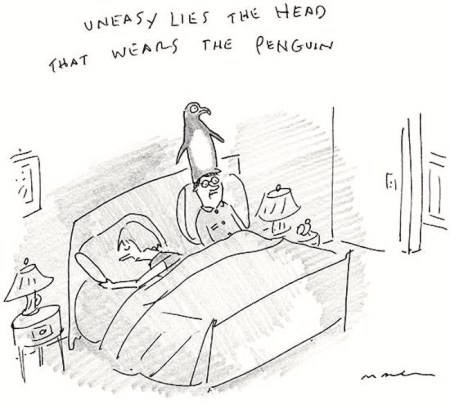You know about Jimmy Buffet Parrotheads, Wisconsin Cheeseheads, annoying dickheads, and musical Radiohead, and now New Yorker cartoonist Michael Maslin brings us PenguinHead:
(Henry IV, Part 2: “Uneasy lies the head that wears a crown.” Often quoted as the crown, as in the adaptation in #1.)
(Hat tip to Michael Palmer.)
Maslin maintains the Ink Spill blog, chronicling New Yorker cartoonists. And he’s published hundreds of cartoons in the magazine. Three (out of many) with some linguistic interest:
Turning on the ambiguity of court (from NOAD2):
a tribunal presided over by a judge, judges, or a magistrate in civil and criminal cases
a quadrangular area, either open or covered, marked out for ball games such as tennis or basketball
Both senses applicable at once.
Turning on tbe ambiguity of doctor (from NOAD2):
a qualified practitioner of medicine, a physician
a person who holds a doctorate
and depending on the question “Is there a doctor in the house?”, used to ask if there’s a physician in a theater (a house in the sense ‘playhouse’), to attend to a medical emergency there. In #3, the request is for a holder of the D.Litt. or a Ph.D. in literature, presumably to act as a script doctor,
a screenwriter or playwright hired by a film, television, or theatre production to rewrite an existing script or polish specific aspects of it (Wikipedia link)
This one is an exercise (another one) in what you have to know to understand what’s going on in a cartoon, and to understand why it might be funny.
You have to recognize that the setting is a doctor’s office, with a large, spherical, spiny fish on the examining table, while the physician is using a stethoscope to examine the patient’s breathing: the doctor tells the patient to inhale, to take a deep breath, and then (in the cartoon) to exhale.
The cartoon is funny only if you recognize the fish as a pufferfish or blowfish, which puffs up and then blows out. On the family, from Wikipedia:
The Tetraodontidae are a family of primarily marine and estuarine fish of the order Tetraodontiformes. The family includes many familiar species, which are variously called pufferfish, puffers, balloonfish, blowfish, bubblefish, globefish, swellfish, toadfish, toadies, honey toads, sugar toads, and sea squab. They are morphologically similar to the closely related porcupinefish, which have large external spines (unlike the thinner, hidden spines of the Tetraodontidae, which are only visible when the fish has puffed up). The scientific name refers to the four large teeth, fused into an upper and lower plate, which are used for crushing the shells of crustaceans and mollusks, their natural prey.
The majority of pufferfish species are toxic and some are among the most poisonous vertebrates in the world. In certain species, the internal organs, such as liver, and sometimes their skin, contain tetrodotoxin and are highly toxic to most animals when eaten; nevertheless, the meat of some species is considered a delicacy in Japan (… fugu), Korea, and China when prepared by specially trained chefs who know which part is safe to eat and in what quantity. Other pufferfish species with nontoxic flesh, such as the northern puffer, Sphoeroides maculatus, of Chesapeake Bay, are considered a delicacy elsewhere.
Uneasy lies the mouth that eats the fugu.





Leave a Reply